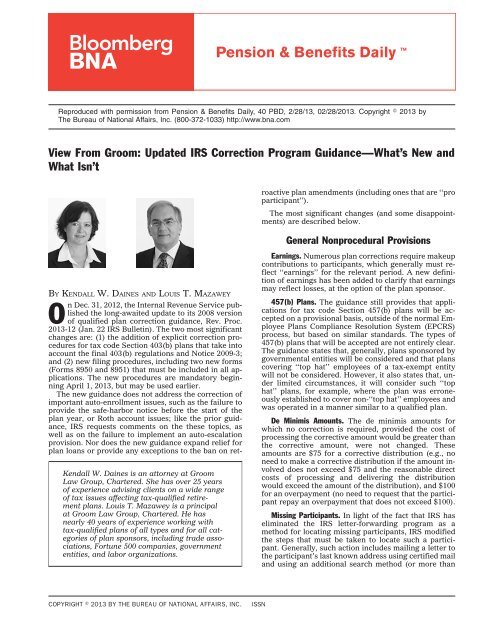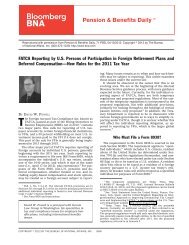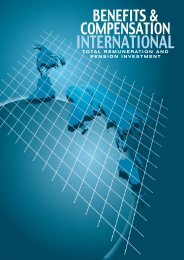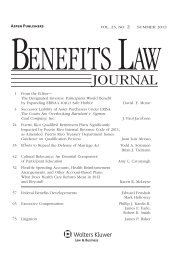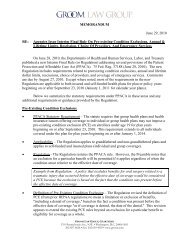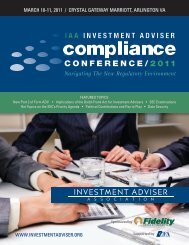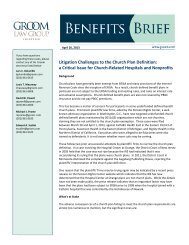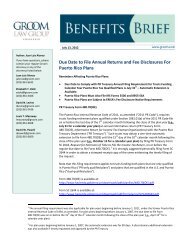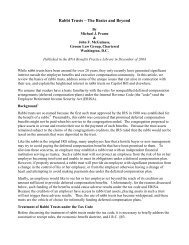View From Groom: Updated IRS Correction Program Guidance
View From Groom: Updated IRS Correction Program Guidance
View From Groom: Updated IRS Correction Program Guidance
You also want an ePaper? Increase the reach of your titles
YUMPU automatically turns print PDFs into web optimized ePapers that Google loves.
Pension & Benefits Daily <br />
Reproduced with permission from Pension & Benefits Daily, 40 PBD, 2/28/13, 02/28/2013. Copyright 2013 by<br />
The Bureau of National Affairs, Inc. (800-372-1033) http://www.bna.com<br />
<strong>View</strong> <strong>From</strong> <strong>Groom</strong>: <strong>Updated</strong> <strong>IRS</strong> <strong>Correction</strong> <strong>Program</strong> <strong>Guidance</strong>—What’s New and<br />
What Isn’t<br />
BY KENDALL W. DAINES AND LOUIS T. MAZAWEY<br />
On Dec. 31, 2012, the Internal Revenue Service published<br />
the long-awaited update to its 2008 version<br />
of qualified plan correction guidance, Rev. Proc.<br />
2013-12 (Jan. 22 <strong>IRS</strong> Bulletin). The two most significant<br />
changes are: (1) the addition of explicit correction procedures<br />
for tax code Section 403(b) plans that take into<br />
account the final 403(b) regulations and Notice 2009-3;<br />
and (2) new filing procedures, including two new forms<br />
(Forms 8950 and 8951) that must be included in all applications.<br />
The new procedures are mandatory beginning<br />
April 1, 2013, but may be used earlier.<br />
The new guidance does not address the correction of<br />
important auto-enrollment issues, such as the failure to<br />
provide the safe-harbor notice before the start of the<br />
plan year, or Roth account issues; like the prior guidance,<br />
<strong>IRS</strong> requests comments on the these topics, as<br />
well as on the failure to implement an auto-escalation<br />
provision. Nor does the new guidance expand relief for<br />
plan loans or provide any exceptions to the ban on retroactive<br />
plan amendments (including ones that are ‘‘pro<br />
participant’’).<br />
The most significant changes (and some disappointments)<br />
are described below.<br />
General Nonprocedural Provisions<br />
Kendall W. Daines is an attorney at <strong>Groom</strong><br />
Law Group, Chartered. She has over 25 years<br />
of experience advising clients on a wide range<br />
of tax issues affecting tax-qualified retirement<br />
plans. Louis T. Mazawey is a principal<br />
at <strong>Groom</strong> Law Group, Chartered. He has<br />
nearly 40 years of experience working with<br />
tax-qualified plans of all types and for all categories<br />
of plan sponsors, including trade associations,<br />
Fortune 500 companies, government<br />
entities, and labor organizations.<br />
Earnings. Numerous plan corrections require makeup<br />
contributions to participants, which generally must reflect<br />
‘‘earnings’’ for the relevant period. A new definition<br />
of earnings has been added to clarify that earnings<br />
may reflect losses, at the option of the plan sponsor.<br />
457(b) Plans. The guidance still provides that applications<br />
for tax code Section 457(b) plans will be accepted<br />
on a provisional basis, outside of the normal Employee<br />
Plans Compliance Resolution System (EPCRS)<br />
process, but based on similar standards. The types of<br />
457(b) plans that will be accepted are not entirely clear.<br />
The guidance states that, generally, plans sponsored by<br />
governmental entities will be considered and that plans<br />
covering ‘‘top hat’’ employees of a tax-exempt entity<br />
will not be considered. However, it also states that, under<br />
limited circumstances, it will consider such ‘‘top<br />
hat’’ plans, for example, where the plan was erroneously<br />
established to cover non-‘‘top hat’’ employees and<br />
was operated in a manner similar to a qualified plan.<br />
De Minimis Amounts. The de minimis amounts for<br />
which no correction is required, provided the cost of<br />
processing the corrective amount would be greater than<br />
the corrective amount, were not changed. These<br />
amounts are $75 for a corrective distribution (e.g., no<br />
need to make a corrective distribution if the amount involved<br />
does not exceed $75 and the reasonable direct<br />
costs of processing and delivering the distribution<br />
would exceed the amount of the distribution), and $100<br />
for an overpayment (no need to request that the participant<br />
repay an overpayment that does not exceed $100).<br />
Missing Participants. In light of the fact that <strong>IRS</strong> has<br />
eliminated the <strong>IRS</strong> letter-forwarding program as a<br />
method for locating missing participants, <strong>IRS</strong> modified<br />
the steps that must be taken to locate such a participant.<br />
Generally, such action includes mailing a letter to<br />
the participant’s last known address using certified mail<br />
and using an additional search method (or more than<br />
COPYRIGHT 2013 BY THE BUREAU OF NATIONAL AFFA<strong>IRS</strong>, INC.<br />
ISSN
2<br />
one, if circumstances warrant), which can include the<br />
Social Security letter-forwarding program, a commercial<br />
locator service, a credit reporting agency, or internet<br />
search tools. A special ‘‘transition’’ rule is included<br />
for plan sponsors that proposed using the <strong>IRS</strong> letterforwarding<br />
program to locate missing participants and<br />
have either received a compliance statement or were<br />
self-correcting an error.<br />
General Procedure Provisions<br />
No significant changes have been made to the procedures<br />
regarding self-correction. However, there are several<br />
significant changes to the VCP procedures, described<br />
below.<br />
Form 8950. The submission must include new Form<br />
8950. This new form includes some of the general information<br />
that was included in Appendices D and F (i.e.,<br />
the applicant’s information, the type of submission and<br />
type of plan), as well as the employer statements, including<br />
the penalties of perjury statement, statements<br />
regarding whether the plan or plan sponsor have been<br />
parties to an abusive tax avoidance transaction, and<br />
whether the plan or plan sponsor is ‘‘under examination.’’<br />
It also includes a checklist, similar to the checklist<br />
previously included in Appendix C.<br />
Form 8951. The submission also must include new<br />
Form 8951, which is a user fee form for Voluntary <strong>Correction</strong><br />
<strong>Program</strong> (VCP) applications. The check, as well<br />
as a copy of the check, must be attached to this new<br />
form. The guidance states that <strong>IRS</strong> may process the<br />
check as an electronic fund transfer.<br />
New Appendix C. Appendices D and F have been combined<br />
into a new Appendix C, which has two parts. The<br />
first part includes much of the information previously<br />
included in Appendices D and F (i.e., the plan and applicant<br />
information, description of the failure and proposed<br />
correction, method of locating missing participants,<br />
description of revised administrative procedures,<br />
requests involving excise taxes, and the enforcement<br />
resolution to be signed by <strong>IRS</strong>). The second part includes<br />
Schedules 1 through 9 (i.e., schedules to be used<br />
to correct failures involving late amendments, salary reduction<br />
simplified employee pension plans (SAR/<br />
SARSEPs), SIMPLE IRAs, plan loans, eligibility, excess<br />
deferrals, and minimum required distributions, as well<br />
as correction by plan amendment), generally unchanged<br />
from the prior guidance, except that Schedule<br />
1, used to correct the failure to timely adopt required or<br />
discretionary amendments, has been clarified to state<br />
that it may be used only for a corrective amendment adopted<br />
before the end of the plan’s determination letter<br />
filing cycle. Under the prior guidance, it was unclear<br />
whether a nonamender failure should be reported on<br />
Schedule 1 or Schedule 2, which is also used to report<br />
nonamender failures. The guidance clarifies that the<br />
schedules may be used only without modification.<br />
Acknowledgement Letter. This has been retained, but<br />
is now located in Appendix D.<br />
Submission of Determination Letter Application. The<br />
rules regarding when a determination letter application<br />
should be included in the VCP application have not<br />
changed, although an attempt has been made to clarify<br />
them. For this purpose, <strong>IRS</strong> added new definitions for<br />
several types of amendments (‘‘good faith amendment,’’<br />
‘‘interim amendment,’’ and ‘‘optional law<br />
change’’), but the rules that apply to each are the same.<br />
If a determination letter application is included, the<br />
new guidance provides that ‘‘stand-alone’’ VCP and determination<br />
letter submissions must be provided and<br />
that, where an item would be includable in both submissions,<br />
two copies of that item must be included. For example,<br />
if a copy of the plan document is required for<br />
both the VCP and determination letter submissions,<br />
then a copy of the plan document must be included in<br />
each part of the submission.<br />
New Mailing Address. VCP submissions should now be<br />
sent to the Covington, Ky., address to which determination<br />
letter applications are sent. Previously, they were<br />
sent to <strong>IRS</strong>’s national office in Washington.<br />
Anonymous Filings. If an anonymous filing is made on<br />
behalf of a plan by the plan’s attorney, the attorney<br />
must sign a new ‘‘penalty of perjury statement’’ to the<br />
effect that the applicant is the plan’s authorized representative<br />
and will file a Form 2848 at the appropriate<br />
time.<br />
<strong>Correction</strong> of Preapproved Plans. In a helpful clarification,<br />
an employer utilizing a preapproved plan document<br />
that must adopt a corrective amendment generally<br />
may continue to rely on the plan sponsor’s advisory/<br />
opinion letter and remain within the six-year remedial<br />
amendment cycle, provided the corrective amendment.<br />
Group VCP Submission. The guidance clarifies that the<br />
VCP compliance fee for a group submission is based on<br />
the number of basic plan documents included in the<br />
submission—not the number of associated adoption<br />
agreements. It also clarifies that a participating employer<br />
must certify it has timely filed a Form 5500 only<br />
for the most recent plan year. The 20-employer minimum<br />
and other rules for group submissions have not<br />
been changed.<br />
Compliance Fee Changes<br />
The general EPCRS fee structure has not changed.<br />
However, several special provisions have been added.<br />
Reduced Fee for Failure to Timely Adopt Determination<br />
Letter. If the sole failure is to timely adopt an amendment<br />
on which a favorable determination letter was<br />
conditioned, the compliance fee is $500, but only if the<br />
amendment is adopted within three months of when it<br />
should have been adopted.<br />
Multiple Failures. The guidance provides that if a VCP<br />
submission includes several failures, each of which is<br />
subject to a reduced fee, the fee will be the lesser of the<br />
sum of the reduced fees or the regular fee.<br />
Multiemployer or Multiple Employer Plans. If a qualification<br />
failure applies to fewer than all participating employers,<br />
the fee can be calculated separately for each<br />
employer, based on the number of that employer’s participants,<br />
rather than on the basis of the employer’s<br />
plan assets.<br />
Fee for Plans Not Required to File Form 5500. Usually,<br />
the compliance fee is based on the number of participants<br />
listed on the most recent Form 5500. For plans<br />
2-28-13 COPYRIGHT 2013 BY THE BUREAU OF NATIONAL AFFA<strong>IRS</strong>, INC. ISSN
3<br />
that are not required to file Form 5500 (e.g., governmental<br />
plans), the fee may be based on the number of<br />
participants as of the last day of the most recently completed<br />
plan year. However, if this information has not<br />
been compiled by the time the VCP submission is<br />
mailed, the number of participants for the plan year before<br />
the most recent plan year may be used, provided<br />
the submission is mailed to the Service no more than<br />
seven months after the close of the most recent plan<br />
year.<br />
Reduced Fee for Failure to Timely Adopt a Written<br />
403(b) Plan. If the sole failure is to timely adopt a written<br />
403(b) plan in accordance with relevant guidance,<br />
the fee is reduced by 50 percent, provided the submission<br />
is filed with <strong>IRS</strong> no later than Dec. 31, 2013.<br />
Fee for Certain Amendment Failures Discovered During<br />
Audit. Two new provisions describe the fee for untimely<br />
adopted amendments discovered during audit, including<br />
determination letter review: (1) If the sole failure is<br />
the plan sponsor’s failure to timely adopt good-faith or<br />
interim amendments, or amendments reflecting optional<br />
law changes by their deadline, but before the expiration<br />
of the plan’s extended remedial amendment<br />
period, the fee is 40 percent of the applicable fee on the<br />
chart included in the guidance; (2) If the sole failure is<br />
the plan sponsor’s failure to timely adopt an amendment<br />
upon which a favorable determination letter was<br />
conditioned, the fee is $1,000, provided the required<br />
amendment has been adopted within three months of<br />
the time it should have been adopted.<br />
Defined Contribution/Section 403(b) Plan<br />
Provisions<br />
Section 403(b) Plan. Generally, the correction of<br />
403(b) plan issues follows the correction methods for<br />
qualified plans under tax code Section 401(a) and is<br />
available for periods before 2009 (although there is no<br />
document requirement applicable for periods before<br />
2009). In addition, a 403(b) failure may be corrected by<br />
treating a contract as a nonqualified annuity under Section<br />
403(c). The guidance expressly provides that the<br />
failure to adopt any written 403(b) plan timely may be<br />
corrected under VCP or the Audit Closing Agreement<br />
<strong>Program</strong>.<br />
Corrective ‘Make-Whole’ Contribution. There had been<br />
an ongoing issue as to whether a plan sponsor should<br />
make a corrective contribution to a defined contribution<br />
or 403(b) plan when a participant receiving an overpayment<br />
does not return the overpayment. The new guidance<br />
provides that such a ‘‘make-whole’’ payment is not<br />
required, but only if the distribution was made in the<br />
absence of a distributable event—for example, an impermissible<br />
in-service distribution—and provided the<br />
amount of the distribution was correctly determined.<br />
Accordingly, the exception is narrow, and a makewhole<br />
contribution will be required in other contexts,<br />
for example, if a participant receives an overpayment<br />
after terminating employment. The guidance also<br />
changes the earnings rate that applies to determine the<br />
amount due from the participant receiving the overpayment.<br />
The prior guidance stated that an ‘‘appropriate’’<br />
earnings rate should be used; the new guidance states<br />
that the ‘‘plan’s earnings rate’’ should be used. The latter<br />
calculation can be quite complex, e.g., for a DC plan<br />
with many investment funds.<br />
Plan Loans. No significant changes were made to the<br />
correction procedures for plan loan failures, although<br />
they now allow correction in Audit CAP. Significantly,<br />
the correction procedures were not expanded to include<br />
any self-correction option that avoids the need to file<br />
corrected 1099-Rs for prior years.<br />
Source of Corrective Contributions. The new guidance<br />
provides that corrective contributions addressing a<br />
plan’s failure to meet the actual deferral percentage/<br />
actual contribution percentage (ADP/ACP) tests must<br />
be qualified nonelective contributions (QNECs) within<br />
the meaning of Treasury Regulation § 1.401(k)-6, indicating<br />
that they must be made from ‘‘new’’ employer<br />
contributions, not from a plan’s forfeiture account. This<br />
is consistent with <strong>IRS</strong>’s informal comments.<br />
<strong>Correction</strong> of QACA Eligibility Failure. If an employee<br />
was not given the opportunity to make an affirmative<br />
election under a qualified automatic contribution arrangement<br />
(QACA), the ‘‘missed deferral opportunity’’<br />
for the first year is 3 percent of the participant’s compensation,<br />
with subsequent increases at the rate prescribed<br />
under tax code Section 401(k)(13)(C)(iii). Accordingly,<br />
the plan sponsor must make a contribution<br />
on behalf of the affected participant equal to 50 percent<br />
of the missed deferral opportunity, along with the<br />
missed matching or nonelective contribution, both adjusted<br />
for earnings. With regard to the nonelective contribution,<br />
the guidance states that the amount is<br />
deemed to be 3 percent of compensation for the period<br />
of the failure.<br />
Corrective Matching Contributions. In the context of<br />
eligibility failures involving a 401(k) plan, if a participant<br />
is owed a corrective contribution to replace missed<br />
matching contributions, the contribution generally may<br />
be an ‘‘employer nonelective contribution.’’ A QNEC is<br />
required for safe harbor plans and will be subject to the<br />
vesting and distribution rules that apply to matching<br />
contributions.<br />
403(b) Plan Failure to Meet the ‘Universal Availability’<br />
Requirement. The guidance states that the correction<br />
provisions applicable to 401(k) plans that fail to timely<br />
enroll participants apply to 403(b) plans correcting a<br />
failure to meet the ‘‘universal availability’’ requirement.<br />
For this purpose, the plan may deem the missed deferral<br />
opportunity to be the greater of 3 percent of compensation<br />
or the maximum deferral percentage for<br />
which the plan provides a 100 percent matching contribution.<br />
SIMPLE IRAs. The guidance states that the correction<br />
provisions applicable to 401(k) plans apply to SIMPLE<br />
IRAs in the context of the improper exclusion of eligible<br />
employees. For this purpose, the missed deferral opportunity<br />
may be deemed to be 3 percent of compensation.<br />
403(b) Plan Failure—Absence of Information-Sharing<br />
Agreement. A permitted correction of a 403(b) failure resulting<br />
from a contract issued in an exchange not being<br />
part of a 403(b) plan due to the failure to have an ‘‘information<br />
sharing agreement’’ is for the assets to be<br />
transferred to another vendor to which contributions<br />
are being made under the plan.<br />
ISSN BNA 2-28-13
4<br />
Defined Benefit Plan Provisions<br />
Adjustment of Corrective Distributions. The guidance<br />
states that corrective distributions from a defined benefit<br />
plan should be increased to reflect the delay in payment<br />
in accordance with the ‘‘plan’s provisions for actuarial<br />
equivalence in effect on the date the distribution<br />
should have been made.’’ The guidance clarifies that<br />
the Section 417(e)(3) factors—the minimum interest<br />
rates for lump-sum and other nonannuity<br />
distributions—do not apply if the corrective distribution<br />
covers missed payments made in forms not subject to<br />
Section 417(e)(3). This is significant in a wide variety of<br />
common failures—such as payments that should have<br />
been made because a timely benefit suspension notice<br />
was not given. It appears that this is mandatory, which<br />
is a significant change because many plans have used<br />
the relatively low Section 417(e)(3) rates in this context.<br />
Coordination With Section 436 Benefit Restrictions.<br />
There are two aspects to this issue. First, if a plan fails<br />
to follow the restrictions of Section 436 (e.g., it makes a<br />
lump-sum payout when it shouldn’t), the correction is<br />
to make the employer contribution necessary so that<br />
the restriction no longer applies, adjusted for earnings.<br />
It may be problematic for affected plan sponsors to<br />
make this correction. Second, a corrective distribution<br />
or amendment is not, in and of itself, subject to the requirements<br />
of Section 436. However, if a plan is subject<br />
to the Section 436 restrictions at the time a correction<br />
(e.g., to correct a minimum required distribution (MRD)<br />
failure) is made, the plan sponsor generally must make<br />
a special contribution to the plan equal to the impermissible<br />
distributions if the distribution was a ‘‘prohibited<br />
payment’’ (e.g., a lump sum) or the increased funding<br />
target attributable to a corrective amendment. Any such<br />
contribution is treated as a ‘‘section 436 contribution’’<br />
and will not count toward minimum funding requirements.<br />
Minimum Required Distributions. The new guidance<br />
provides that, in correcting a failure to make minimum<br />
required distributions pursuant to tax code Section<br />
401(a)(9), the plan must make the ‘‘missed’’ payments,<br />
adjusted for interest based on the plan’s actuarial<br />
equivalence factors in effect on the date the distribution<br />
should have been made. Previously, the correction<br />
guidance did not explicitly state what the interest rate<br />
should be based on—many plans used the Section<br />
417(e)(3) rates for this purpose. This will typically result<br />
in larger payments.<br />
Closing Observations<br />
<strong>IRS</strong>’s voluntary correction program has come a long<br />
way in the more than 20 years since <strong>IRS</strong> first established<br />
a policy in this area. It has essentially reversed<br />
the mind-set of plan sponsors and administrators from<br />
simply correcting the problem going forward to correcting<br />
the problem for all periods and filing thousands of<br />
VCP applications annually.<br />
Hopefully, the new procedures for VCP submissions<br />
will improve <strong>IRS</strong> response times and help reduce the<br />
backlog of applications. Unfortunately, the updated<br />
guidelines do not contain the types of changes that expand<br />
the ability of plan sponsors and administrators to<br />
self-correct more types of violations, though 403(b)<br />
plans will benefit from greater parity with qualified<br />
plans in the correction process.<br />
In our experience, plan loan violations and retroactive<br />
amendments still are among the most common areas<br />
for which submissions are made. A key reason is<br />
that <strong>IRS</strong> guidance continues to generally force plans to<br />
go through VCP to avoid onerous 1099-R corrections/<br />
penalties (in the case of plan loans) and Audit CAP risks<br />
(for ‘‘retro’’ amendments). Hopefully, <strong>IRS</strong> will see its<br />
way to give more leeway in these areas in future iterations<br />
of EPCRS.<br />
2-28-13 COPYRIGHT 2013 BY THE BUREAU OF NATIONAL AFFA<strong>IRS</strong>, INC. ISSN


